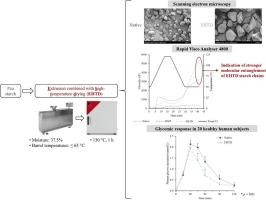改变豌豆淀粉功能和降低血糖反应的新型水热改性技术
IF 10.7
1区 化学
Q1 CHEMISTRY, APPLIED
引用次数: 0
摘要
尽管热水分处理(HMT)是一种有效的清洁标签方法,但由于难以扩大规模,在工业中并不常用于淀粉改性。本研究旨在开发一种新方法,即使用挤压结合高温干燥(EHTD)来替代 HMT 进行淀粉改性。豌豆淀粉的水分含量为 37.5%,在低温条件下(≤ 65 °C)进行挤压,然后立即在 130 °C 下加热 1 小时。总体而言,与原生豌豆淀粉相比,EHTD 改性豌豆淀粉的糊化温度升高,糊化焓变降低,糊化粘度和凝胶硬度降低,抗酶性增强。更重要的是,在一项人体喂养试验中(n = 20 名健康参与者),在食用水煮样品(35 克淀粉,干基)2 小时后监测血浆葡萄糖反应,与原生豌豆淀粉相比,EHTD 改性豌豆淀粉的血浆葡萄糖增量曲线下面积减少了 22%(p < 0.01)。结果表明,EHTD 是一种生产功能性低血糖淀粉配料的简单、无标签的新方法。本文章由计算机程序翻译,如有差异,请以英文原文为准。

Novel hydrothermal modification to alter functionality and reduce glycemic response of pea starch
Despite being an effective and clean-label method, heat-moisture treatment (HMT) is not commonly used for starch modification in industry due to the difficulty of scale-up. This study aimed to develop a novel method of using extrusion combined with high-temperature drying (EHTD) as an alternative to HMT for starch modification. Pea starch was subjected to extrusion at 37.5 % moisture level and with a low-temperature profile (≤ 65 °C), followed by immediate heating at 130 °C for 1 h. EHTD significantly damaged the granules, altered the X-ray diffraction pattern, and reduced the relative crystallinity of pea starch. Overall, EHTD-modified pea starch exhibited increased gelatinization temperatures and decreased gelatinization enthalpy change, lowered pasting viscosity and gel hardness, as well as enhanced enzymatic resistance than the native pea starch. More importantly, in a human feeding trial (n = 20 healthy participants) to monitor plasma glucose response over a period of 2 h after consuming water-boiled sample (35 g starch, dry basis), EHTD-modified pea starch exhibited 22 % reduction (p < 0.01) in plasma glucose incremental area under the curve as compared to the native counterpart. The results indicated that EHTD could be a new simple and clean-label method to produce functional and low-glycemic starch ingredients.
求助全文
通过发布文献求助,成功后即可免费获取论文全文。
去求助
来源期刊

Carbohydrate Polymers
化学-高分子科学
CiteScore
22.40
自引率
8.00%
发文量
1286
审稿时长
47 days
期刊介绍:
Carbohydrate Polymers stands as a prominent journal in the glycoscience field, dedicated to exploring and harnessing the potential of polysaccharides with applications spanning bioenergy, bioplastics, biomaterials, biorefining, chemistry, drug delivery, food, health, nanotechnology, packaging, paper, pharmaceuticals, medicine, oil recovery, textiles, tissue engineering, wood, and various aspects of glycoscience.
The journal emphasizes the central role of well-characterized carbohydrate polymers, highlighting their significance as the primary focus rather than a peripheral topic. Each paper must prominently feature at least one named carbohydrate polymer, evident in both citation and title, with a commitment to innovative research that advances scientific knowledge.
 求助内容:
求助内容: 应助结果提醒方式:
应助结果提醒方式:


